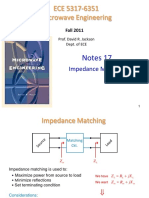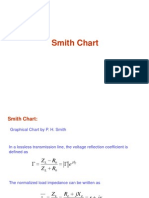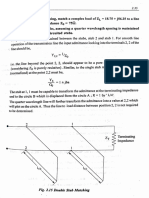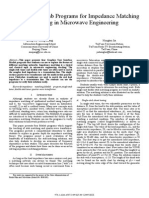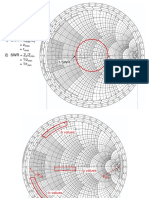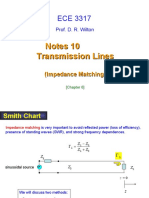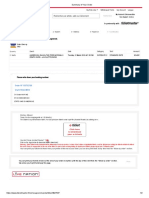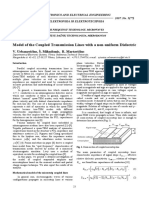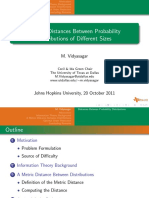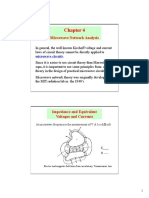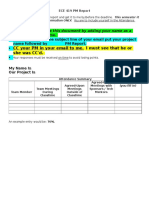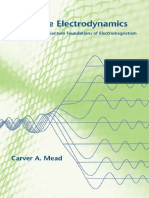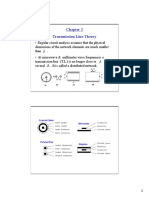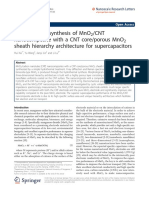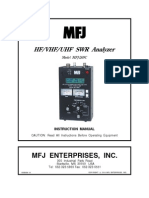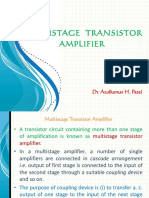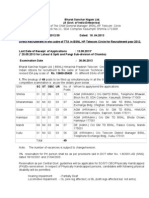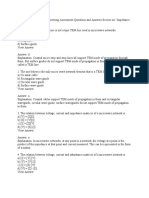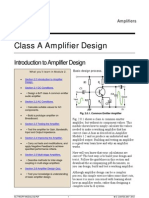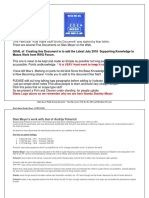Double-Stub Tuner
It is a matching network consisting of two
adjustable stubs fixed in position on the
t
transmission
i i line
li
The spacing of the stubs is not critical
An odd number of
impedances
/8
will match a wide range of
In our examples we will use a stub of separation of
/8
For proper matching the input normalized
admittance to the left of junction 2-2 should be unity.
�Since stub2 adds susceptance only to the line, the
normalized admittance to the right of junction 2-2 must be
of the form 1+jb.
That means that the admittance to the right of 2-2 junction
must appear on the dashed circle A below.
below
The / 8
transformer (between the two stubs) will transform
all the admittances that lie on circle A to points on circle B which
is displaced toward the load from circle A.
Basically, the idea is:
Get stub1 to transform the input impedance of the line and load
to the right of junction 1-1 into an admittance with a locus
on circle B
1) The / 8 transformer will transform the admittance value
(just to the right
(j
g of 2-2)) on the locus circle A with a value
of 1+jb.
2) Stub2 is then used to cancel the +jb component to end up
wit ha normalized admittance of 1.
�Example
The normalized admittance of the load on a line is 0.3-j2.0.
This is to be matched to the line by a double stub spaced / 8
apart with the nearest stub 0.1 from the load.
apart,
load
Solution:
1) The admittance seen to the right of stub1 is found by rotating
the normalized admittance point (0.3-j2) a distance 0 . 1
towards the generator.
That value is 0.08-j0.53 (point 1 on the chart)
2) Stub 1 adds susceptance to the line so that the admittance lies
on circle B
That corresponds to point 0 on the smith chart and has the value
of 0.08+j0.6
That means that stub 1 must add a normalized susceptance of
(0.08+j0.6) (0.08-j0.53) = j1.13
�The length L1 of stub 1 is found to be 0 . 385 which can be
evaluated by rotating along the generator circle from the infinite
admittance point until an admittance of j1.13 is found
3) Next
N
bby moving
i a / 8 distance
di
from
f
point
i 1-1
1 1 to point
i 2-2
22
we reach point 2 on circle A.
That point corresponds to the value 1+j3.9 on the chart
Stub 2 must be adjusted to yield a susceptance of -j3.9 to
achieve the final match.
match
From the Smith Chart L2 is found to be equal to 00. 04
. 04 by
rotating towards the generator from the infinite admittance point
until an admittance of j3.9 is found
�Another Example : Double-stub Matching
The terminating impedance Zl is 100 +j100 and the
characteristic impedance Z0 of the line and stub is 50 . The first
stub is placed at 0.40 away from the load. The spacing between
the two stubs is 3/8. Determine the length
g of the short-circuited
stubs when the match is achieved. What terminations are forbidden
for matching the line by the double-stub device?
Solution
1. Compute the normalized load impedance Zl and enter
it on the Smith Chart :
Zl =
100 + j100
= 2 + j2
50
2. Plot a SWR circle and read the normalized load
admittance 180o out of phase with Zl on the SWR
circle:
y l = 0 .25 j 0 .25
�3. Draw the spacing circle of 3/8 by rotating the constantconductance unity circle (g=1) through a phase angle of
2d=23/8=3/2 toward the load. Now y11 must be on this spacing
circle, since yd2 will be on the g=1 circle (y11 and yd2 are 3/8 apart).
44. Move
M
yl for
f a distance
di t
off 0.40
0 40 from
f
0 458 to
0.458
t 0.358
0 358 along
l
the
th
SWR circle toward the generator and read yd1 on the chart:
yd1=0.55-j1.08
5. There are two possible solutions for y11. They can be found by
carrying yd1 along the constant-conductance (g=0.55) circle that
intersects the spacing circle at two points:
. y11=0.55-j1.01
y11=0.55-j1.88
6. At the junction 1-1,
y11=yd1+ys1
Then
ys1=y11-yyd1=(0.55-j0.11)-(0.55-j0.08)=+j0.97
=(0 55 j0 11) (0 55 j0 08)=+j0 97
Similarly,
ys1= -j0.80
7. The lengths of stub 1 are found as
l1= ((0.25+0.123)) =0.373
l1= (0.25-0.107) =0.143
8. The 3/8 section of line transforms y11 to yd2 and y11 to yd2 along
their constant standing-wave circles, respectively. That is:
�yd2=1-j0.61
yd2=1+j2.60
9. Then stub 2 must contribute
ys2=+j0.61
ys2=-j2.60
10. The lengths of stub 2 are found as
l2= (0.25+0.087) =0.337
l2= (0.308-0.25) =0.058
11. It can be seen from the Smith Chart that a normalized yl located
inside the hatched area cannot be brought to lie on the locus of y11 or
y11 for a possible match by the parallel connection of any shortcircuited stub because the spacing circle and g=2 circle are mutually
tangent.
Thus the area of a g=2 circle is called the forbidden region of the
normalized load admittance for possible match.
�The Quarter Wave
Transformer
If only a narrow band impedance match is required, a
single-section
i l
ti transformer
t
f
is
i goodd enough.
h
One drawback: it can only be used to match a real load
impedance.
Multi-section /4 Transformers can be used to achieve
optimum matching characteristics over a desired
frequency band.
Consider the following quarter lambda Transformer
l = =
Z in = Z1
With l = =
Z L + jZ1 tan l
Z1 + jZ L tan l
(1)
at the design frequency fo
Since
and Z
2
1
Z
Z
= Z
in
Z
+ Z
in
at the point where Zo and Zin meet
we can show that:
ZL Z0
Z L + Z 0 + j 2 tan l Z 0 Z L
(2)
This equation is valid for a single /4 Transformer only. The
magnitude of the reflection coefficient is:
If
and since
becomes:
{1 + [4 Z
then
fo
(sec
Z
cos
0
y2
(3)
1 )
and
Z L / (Z L Z 0 ) sec
2
equation (3)
for
(4)
The next Figure shows the approximate behavior of
the single l transformer.
4
�=2(/2-m) is the bandwidth within which < m
At =m we get = m
For TEM lines:
= l =
and
fo
fo
(5)
Fractional bandwidth:
f
2( fo fm
=
fo
fo
f
4
= 2
cos
fo
)=
1
2 fm
4
= 2
fo
m
1 m2
2 Z oZ L
ZL Zo
(6)
(7)
10
�Reflection coefficient magnitude as a function of f
various load mismathes
for
The Theory of Small Reflections
For more bandwidth, multi-section /4 transformers are
used.
To design a multiple /4 let us look at the reflections that occur
in a T.L. Consider the figure below:
11
�The partial and T are:
1 =
Z 2 Z1
Z Z2
; 2 = 1 ; 3 = L
Z 2 + Z1
ZL + Z2
T21 = 1 + 1 =
2Z 2
2Z1
; T12 = 1 + 2 =
Z1 + Z 2
Z1 + Z 2
The total reflection seen at the feed line is:
= 1 + T12T213e 2 j + T12T21232 e 4 j + ...
= 1 + T12T213e
2 j
e
n =0
n n 2 j
2 3
(8)
using the geometric series:
n = 0
1
1 x
for
equation (8) becomes:
T 12 T 21 3 e 2
= 1 +
1 23e 2
j
j
(9)
using 2= -1, T21=1+ 1, and T12= 1-1
1 + 3 e 2 j
We get: =
1 + 1 + 3 e 2 j
(10)
12
For
j 2
(11)
are the dominant components
The same concept can be extended to the
Multisection Transformer.
0 =
Z1 Z0
Z Z
Z Z
; n = n+1 n ; N = L N ;
Z1 + Z0
Zn+1 + Zn
ZL + Z N
We can approximate the total as:
( ) 0 + 1e 2 j + 2 e 4 j + ... + N e 2 jN
( )
(12)
If the Transformers are made symmetrical then:
13
�for N even
( ) = e
jN
0 cos N + 1 cos(N 2) + ... + n cos( N 2n) + ... +
N / 2
2
2
or
(13)
for N odd
0 cosN + 1 cos( N 2) +...+ n cos(N 2n) +...+
( ) = 2e jN
( N1)/ 2 cos
(14)
The idea is to use these equations to synthesize any
desired as a function of f, by choosing the
appropriate # of sections (N) and reflections ns.
There are two main approaches:
The binomial (maximally flat) or
the Chebystev (equal ripple) approach.
14
�Binomial Transformer
Given a certain number of sections, the response () is
flat around the design frequency.
Basically we set:
= 2 N A cos
(15)
We can determine A by setting:
f
0 = l = 0 equation (15) becomes:
(0 )
= 2
Z
Z
L
L
Z
+ Z
(16)
0
0
at f=0, all sections are of zero length and l=0 for
all of them.
A = 2N
ZL - Z0
ZL + Z0
(17)
() can be expanded also as:
)=
n=0
N
n
N
n
N!
( N n )! n !
e 2
jn
Binomial coefficients
(18)
(19)
CnN = C NN n , C0N = 1, C1N = N = C NN1
15
�The design procedure is as follows:
Choose a and match it to the:
N
( ) = A
C nN e 2
= 0 + 1 e 2
n=0
jn
+ ... + N e 2
jN
(20)
That also means:
1 = ACnN ; 2 = AC2N ; 3 = AC3N ...
n = AC nN
or
(21)
at each interface we have:
n =
Z n +1 Z n
Z
1
ln n + 1
Z n +1 + Z n
Zn
2
(22)
Matching equation (22) and (21) yields:
ln
also
Z n +1
= 2 AC
Zn
N
n
2(f0 fm
f
=
f0
f0
= 2
cos
ZL
Z0
2 N C nN ln
(23)
)=
1 m
2 A
1
N
16
�Example
Design a 3 section binomial transformer to match a
50 load to a 100 line and calculate the
b d idth for
bandwidth
f
Pl t the
th results
lt for
f 1,2,3,4,
1234
m = 0.05 . Plot
and 5 sections
Solution:
For N=3 , ZL=50 Ohm, Zo=100 Ohm we get:
A = 2N
1
ZL - Z0
Z
N + 1 ln L = 0 . 0433
2
ZL + Z0
Zo
The bandwidth is then:
f
4
= 2
cos
f0
= 2
cos
1
2
1 0 . 05
2 0 . 0433
3
= 0 . 70 , or 70 %
1
N
The necessary binomial coefficients are:
C
3
0
C 13
C
3
2
3!
= 1
0 )!0 !
3!
=
= 3
(3 1 )!1!
3!
=
= 3
(3 2 )! 2 !
=
(3
17
�The characteristic impedances are:
n = 0 ln Z 1 = ln Z
= ln 100 + 2 3 ( 1 ) ln
+ 2 3 C
50
100
3
0
ln
Z
Z
= 4 . 518
Z 1 = 91 . 7
n = 1 ln Z
= ln Z 1 + 2 3 C 13 ln
= ln 91 . 7 + 2 3 ( 3 ) ln
Z
= ln Z
= ln 70 . 7 + 2 3 ( 3 ) ln
3
= 4 . 26
= 70 . 7
n = 2 ln Z
50
100
Z
Z
+ 2 3 C
50
100
3
2
ln
Z
Z
= 4 . 00
= 54 . 5
18
�19













